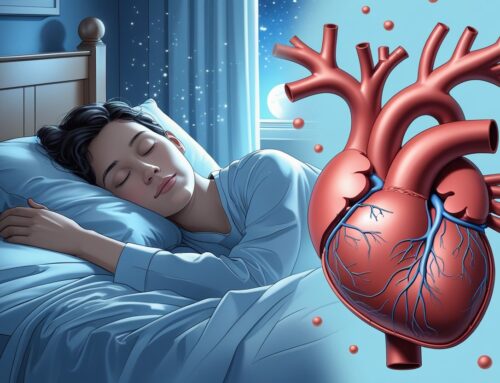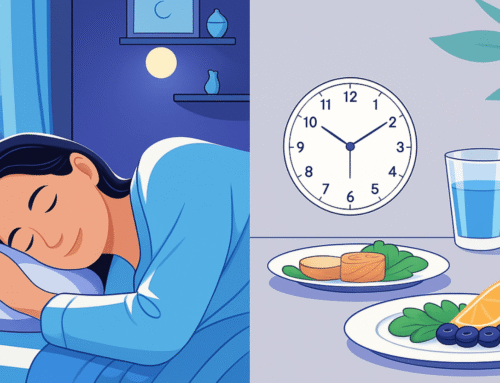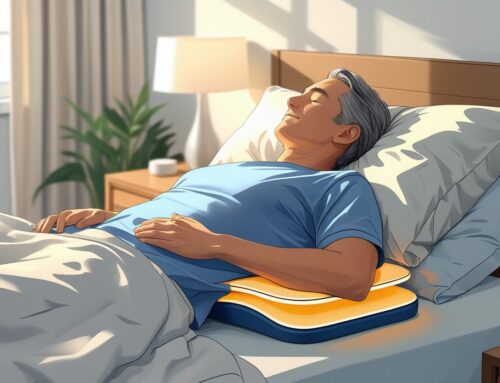Post nasal drip makes sleeping difficult because mucus builds up and irritates the throat. The best way to sleep with post nasal drip involves elevating the head to prevent mucus from pooling and causing discomfort. This simple position helps reduce coughing and improves breathing throughout the night.
Sleeping on the back with the head propped up on pillows is the most effective method. If one side feels more congested, sleeping on that side may provide relief. Staying hydrated and using a humidifier also thin mucus and ease symptoms at night, resulting in better overall comfort.
Many people wake up feeling unrested because post nasal drip disrupts their sleep. Sleeping position and bedtime habits help in comfort and rest quality. Learning these techniques manages symptoms and promotes a more restful night.
Key Takeaways
- Elevating the head improves sleep by reducing mucus buildup.
- Staying hydrated and managing air moisture help thin mucus.
- Adjusting sleep position eases breathing and reduces coughing.
- A supportive mattress that encourages side sleeping with head elevation helps reduce post-nasal drip by improving mucus drainage and maintaining proper breathing posture.
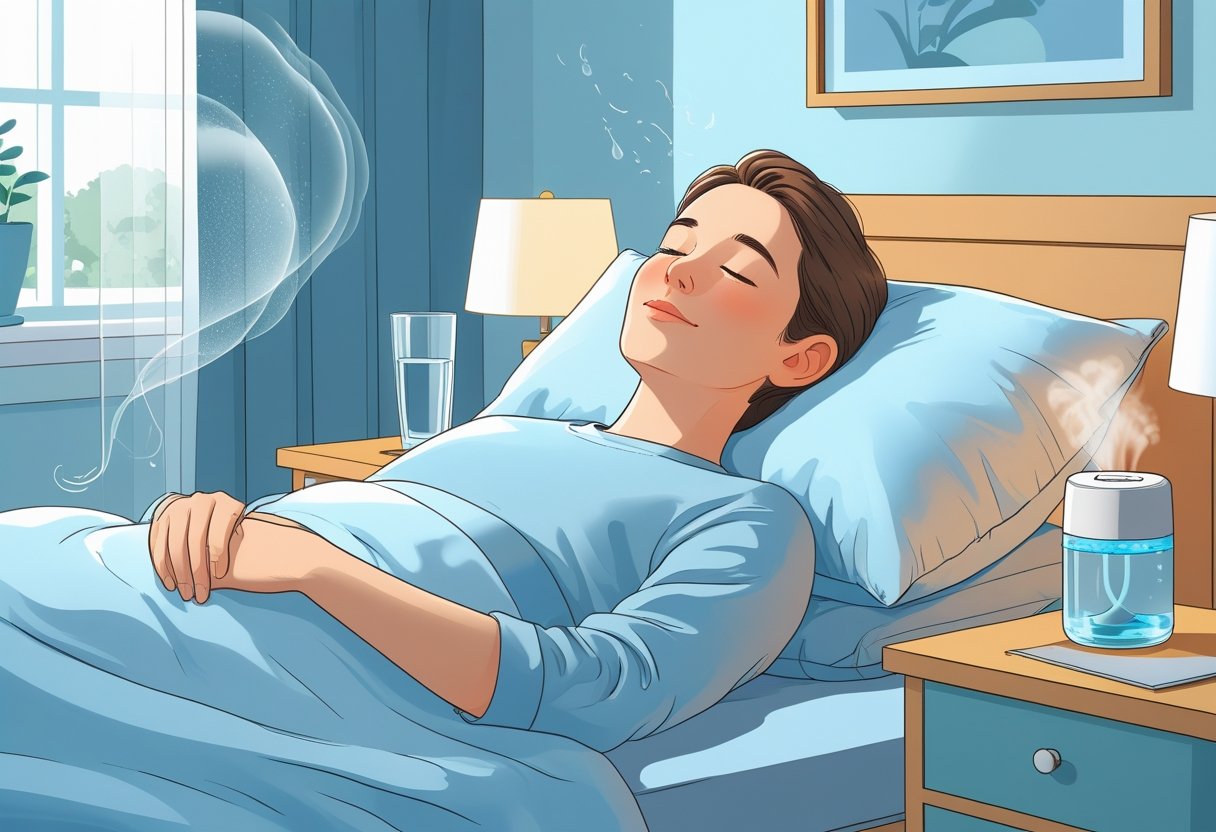
Understanding Post Nasal Drip at Night
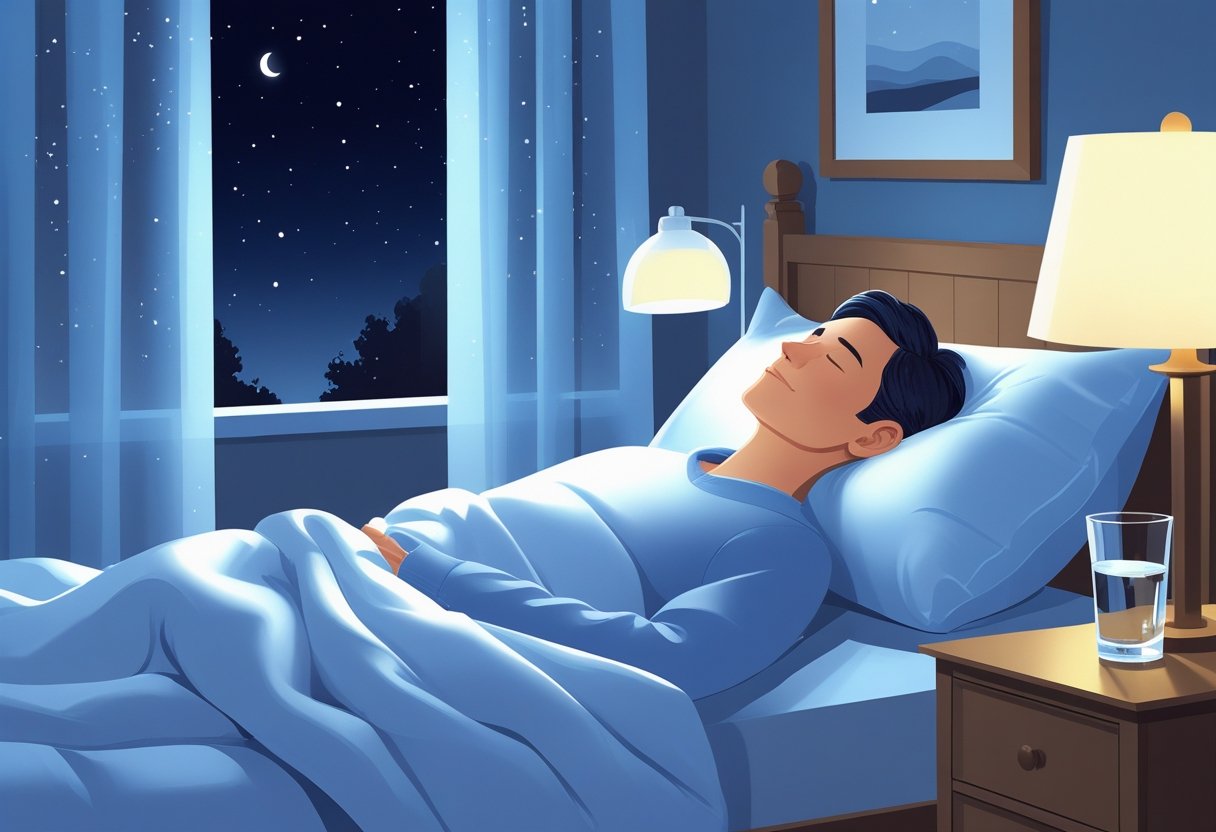
Post nasal drip occurs when mucus collects in the back of the nose and throat. At night, this mucus tends to build up more and cause irritation. Several factors worsen post nasal drip while lying down, disrupting normal sleep patterns and causing discomfort.
What Is Post Nasal Drip
Post nasal drip happens when excess mucus from the nose drips down the back of the throat. Normally, mucus traps dust, germs, and other particles to protect the body. However, too much mucus causes throat irritation and coughing.
Mucus thickness varies. Thick mucus feels stickier and irritates the throat more often. This usually happens with allergies, colds, or infections. Post nasal drip may cause the sensation of mucus stuck in the throat or frequent throat clearing.
Why Post Nasal Drip Is Worse at Night
When a person lies down, gravity no longer helps drain mucus from the nasal passages. Instead, mucus pools at the back of the throat, which causes increased irritation and coughing.
Additional factors at night include dry air from heaters or air conditioners. Dry air thickens mucus and makes it feel heavier. Acid reflux also worsens post nasal drip by increasing throat sensitivity. Elevating the head during sleep can help reduce this problem by allowing mucus to drain more easily and lowering the risk of reflux.
Common Causes of Post Nasal Drip at Night
Several conditions trigger post nasal drip at night. Allergies stand out as a major cause, especially from exposure to dust mites or pet dander in bedding. Cold or flu infections increase mucus production as well.
Environmental factors such as dry air or irritants like cigarette smoke aggravate nasal drip during sleep. Sinus infections or structural nasal problems also contribute. Sometimes acid reflux at night irritates the throat and stimulates mucus production.
How Post Nasal Drip Disrupts Sleep
Post nasal drip leads to coughing, throat clearing, and choking sensations throughout the night. This results in frequent awakenings and difficulty falling asleep. Irritated airways cause discomfort and sore throats. The mucus drip may trigger sneezing or wheezing, making quiet breathing difficult. These interruptions reduce sleep quality and cause daytime tiredness.
Sleeping with the head elevated prevents mucus from pooling at the back of the throat. Other measures, such as using a humidifier or treating allergies, improve sleep quality for those affected by post nasal drip at night.
Optimal Sleeping Positions for Post Nasal Drip Relief
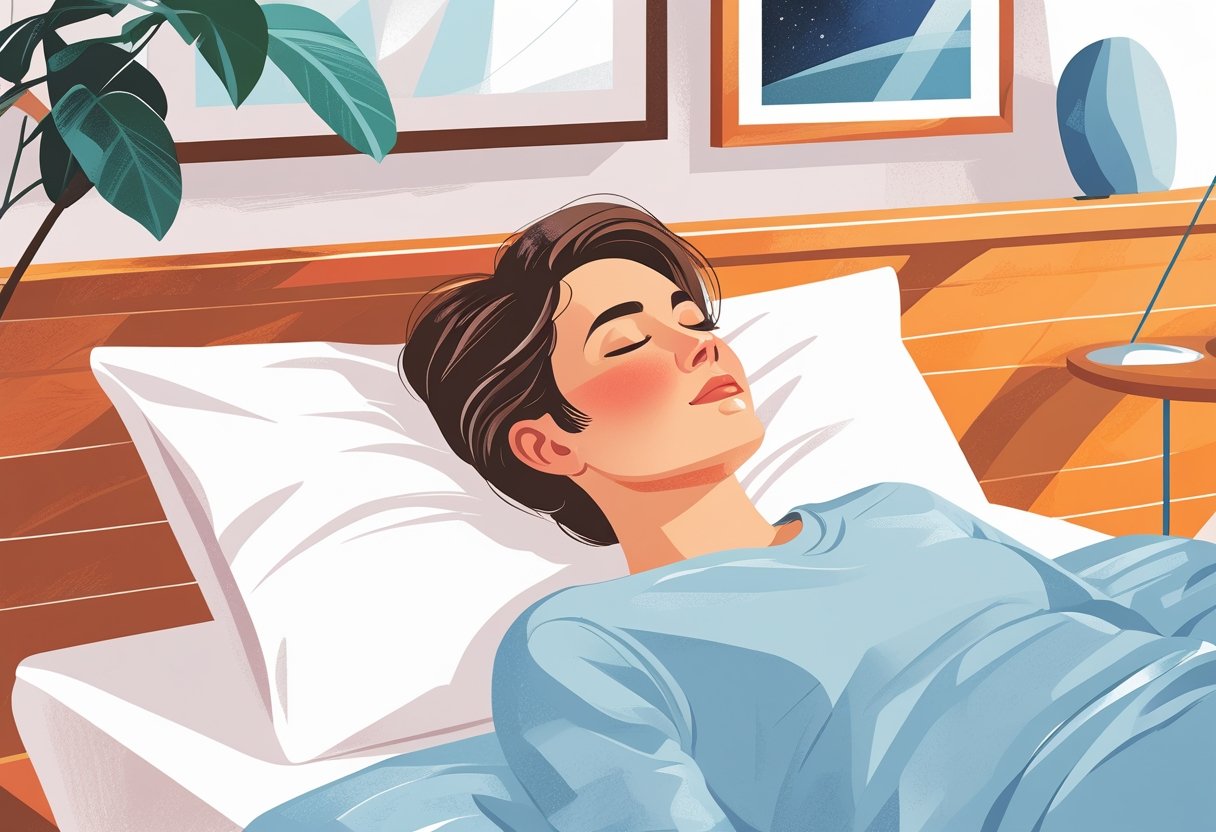
Choosing the right sleeping position can reduce mucus buildup and ease sinus drainage at night. Elevating the head and avoiding certain postures prevents mucus from pooling in the throat, which lowers irritation and coughing.
Best Sleeping Position for Post Nasal Drip
Sleeping with the head and upper body elevated proves to be the best way to manage post nasal drip. Using a wedge pillow or stacking extra pillows raises the head by about 7 to 12 inches. This position helps mucus drain away from the throat instead of collecting there, which reduces throat discomfort and coughing during sleep.
Side sleeping also provides relief. It encourages one sinus passage to drain better while minimizing mucus accumulation. Keeping the body slightly reclined allows sinuses to clear more effectively, thereby easing nighttime symptoms.
Sleeping Position to Avoid Sinus Drainage
Sleeping flat on the back or stomach should be avoided when managing sinus drainage at night. Lying flat increases sinus pressure, making drainage difficult and often worsening post nasal drip.
The stomach position causes mucus to pool in the throat, which leads to more irritation. Additionally, it can exacerbate acid reflux, sometimes worsening post nasal drip symptoms. Avoiding these positions reduces mucus buildup and supports clearer breathing.
How to Sleep to Avoid Post Nasal Drip
To sleep well with nasal drip, the key lies in maintaining elevation and good posture. Keep the head higher than the chest by using a pillow or wedge. This prevents mucus from settling at the back of the throat where it triggers coughing or throat clearing.
Furthermore, sleeping on the side helps keep sinuses open and promotes better drainage. Avoid heavy bedding around the head and maintain a humid but allergen-free environment to limit mucus production. These steps improve comfort and reduce post nasal drip only during the night.
Nighttime Habits to Reduce Post Nasal Drip
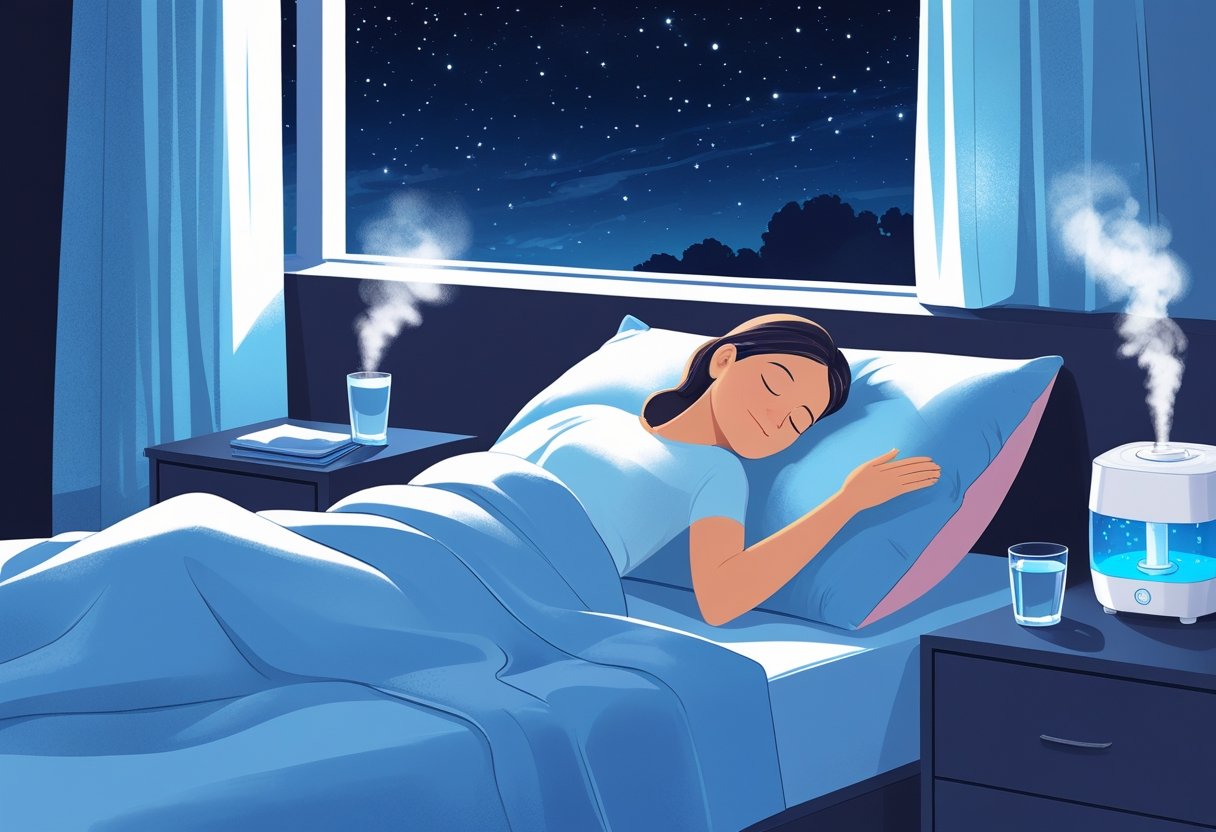
Managing post nasal drip at night requires specific actions before bed, adjusting the bedroom setup, and controlling allergens. These steps work together to reduce mucus buildup, ease breathing, and help prevent discomfort that causes restless sleep.
Pre-Bedtime Routines
Clearing nasal passages before sleep proves essential to stop post nasal drip at night. Using a saline nasal rinse an hour or two before bed flushes out mucus, dust, and allergens. This prevents mucus from pooling and causing irritation.
Drinking plenty of water throughout the evening keeps mucus thin and less likely to block airways. Some people find that a short steam inhalation, such as from a hot shower, temporarily moistens dry nasal passages and loosens mucus.
Avoid eating large meals or acidic foods close to bedtime, since acid reflux worsens post nasal drip and makes sleep more difficult. Over-the-counter nasal decongestants may provide relief but should not be taken for many consecutive days.
Bedroom Environment Improvements
Positioning also influences how well a person sleeps with post nasal drip. Raising the head with extra pillows prevents mucus from gathering in the throat. This limits coughing and throat clearing, both of which disrupt sleep. Using a humidifier maintains moist air, which reduces irritation in the nose and throat. Dry air tends to thicken mucus and aggravate symptoms.
Regularly cleaning bedding and vacuuming reduce dust and allergens that trigger post nasal drip. Removing strong scents such as perfumes and cleaning agents helps minimize nasal irritation during sleep.
Allergen Management Strategies
Controlling allergens in the home reduces triggers for post nasal drip that interfere with rest. Keeping windows closed during high pollen times decreases allergic reactions. Washing pillowcases and sheets weekly in hot water eliminates dust mites. Using hypoallergenic covers on pillows and mattresses prevents allergen buildup.
Pets contribute allergens, so keeping them out of the bedroom may provide relief. Selecting an air purifier equipped with a HEPA filter also lowers airborne allergens.
These allergen control measures limit nasal inflammation responsible for mucus buildup, making breathing easier and allowing uninterrupted sleep.
Relief Techniques and Remedies for Better Sleep
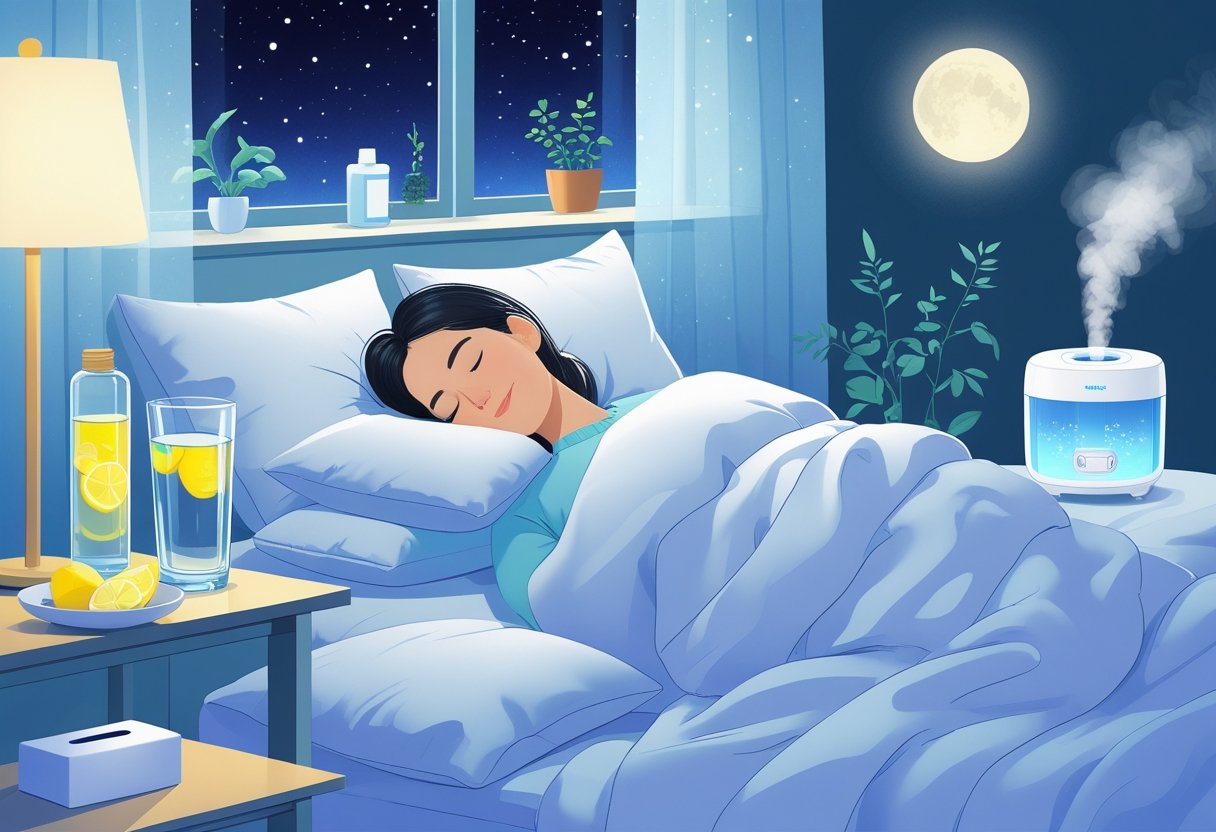
Post-nasal drip at night causes discomfort and disrupts sleep. Effective relief comes from clearing mucus, improving air quality, and easing inflammation. These steps reduce sinus drainage in the throat and make breathing more comfortable during sleep.
Nasal Irrigation Methods
Nasal irrigation offers a simple and effective way to clear excess mucus that causes post-nasal drip. Rinsing the nasal passages with a saline solution flushes out allergens, dust, and mucus buildup. This approach eases sinus drainage in the throat and reduces irritation.
Devices such as neti pots or saline spray bottles remain popular for nasal rinsing. It is crucial to use sterile, distilled, or boiled water mixed with saline powder or salt to avoid infections. Performing this rinse before bed significantly decreases mucus accumulation and improves breathing during sleep.
Use of Humidifiers and Air Purifiers
Dry or polluted air often worsens post-nasal drip during the night. A humidifier adds moisture to the air, which keeps the nasal passages hydrated and less irritated. This prevents thick mucus from forming and enhances comfort overnight.
Air purifiers equipped with HEPA filters remove allergens such as dust, pollen, and pet dander that trigger mucus production. Maintaining good air quality in the bedroom proves key to reducing sinus drainage in the throat and improving sleep quality for those who suffer from post-nasal drip.
Appropriate Over-the-Counter Medications
Over-the-counter (OTC) remedies help manage symptoms of post-nasal drip at night. Antihistamines reduce allergic reactions that cause mucus buildup. Decongestants shrink nasal tissues, allowing better airflow.
Choosing non-drowsy antihistamines suits daytime use, while mild sedative options at night promote sleep. However, decongestant sprays require short-term use to avoid rebound congestion. Consulting a healthcare professional ensures safe and effective use of these medications.
Managing Nighttime Cough From Sinus Drainage
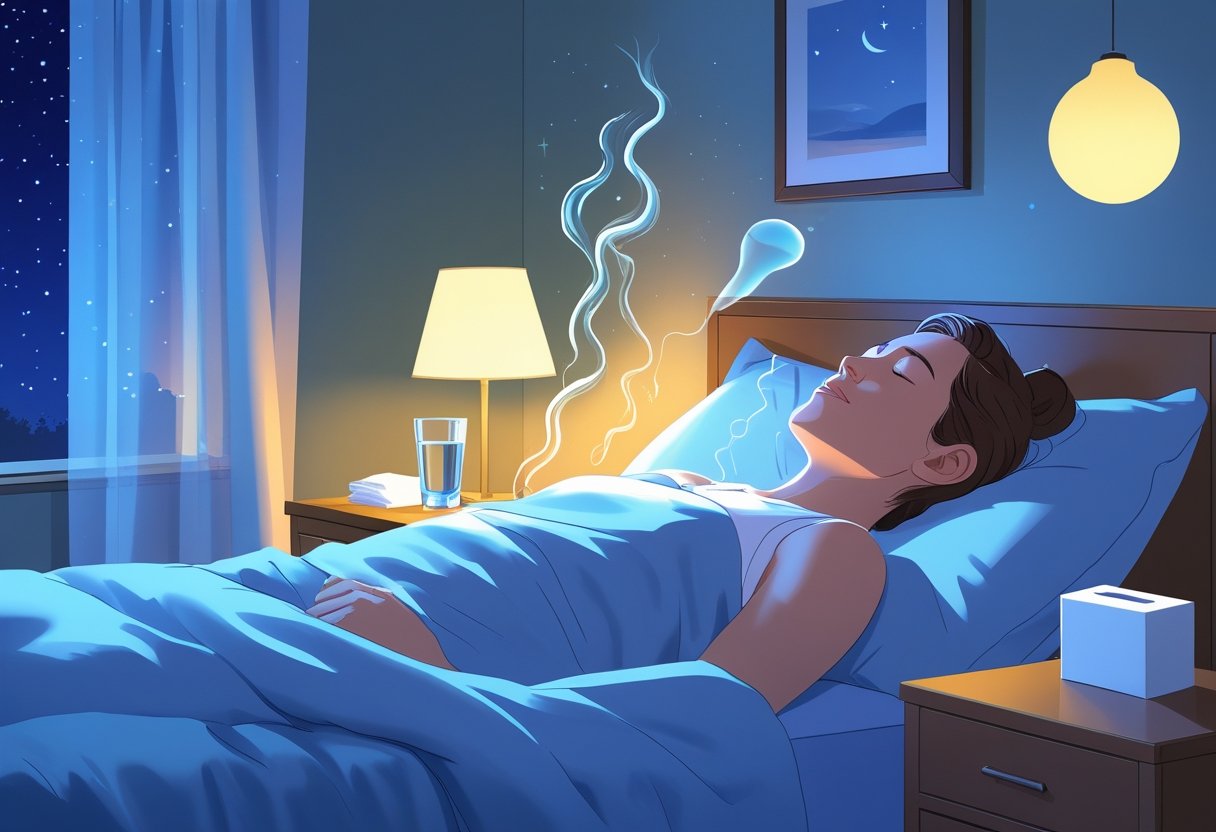
Coughing from sinus drainage often worsens at night because lying down alters mucus movement. Managing this type of cough requires understanding its cause and using specific strategies to reduce irritation and stop the cough.
Why Cough Worsens at Night
At night, mucus from the sinuses tends to collect in the back of the throat. When a person lies flat, gravity no longer assists in draining mucus down the throat. Instead, it drips slowly, which can trigger a cough reflex.
This post-nasal drip cough is usually dry and often disrupts sleep. The dryness also leads to a sore throat, which worsens the coughing cycle. Sinus congestion thickens the mucus, increasing irritation.
Breathing changes during sleep reduce the body’s ability to clear mucus, which makes nighttime post-nasal drip cough more common. Allergies or infections may cause inflammation and intensify symptoms.
Techniques to Prevent Coughing
Sleeping with the head elevated by using extra pillows or a wedge helps prevent mucus from pooling in the throat. Elevation allows for better drainage.
A nasal rinse before bed clears out mucus and reduces irritation. Staying well-hydrated thins the mucus and makes it easier to clear from the sinuses. Other useful methods include running a humidifier to maintain moist air and prevent throat dryness. Avoiding smoke and strong irritants also helps reduce coughing.
Using nasal steroid sprays under a doctor’s guidance decreases sinus inflammation and improves mucus flow. Combining these approaches can control post-nasal drip cough at night and improve sleep quality.
When to See a Doctor About Post Nasal Drip Sleep Problems
Persistent post nasal drip symptoms that disrupt sleep may indicate a need for medical attention. Recognizing specific signs and understanding the potential health issues behind them is essential. Taking timely action helps prevent complications and improves sleep quality.
Signs Your Condition Needs Medical Attention
When post nasal drip leads to worsening symptoms or sleep loss that lasts beyond 10 days, it becomes a warning sign. Other symptoms such as fever, severe headache, facial pain, or thick yellow or green mucus may point to an infection or another underlying issue.
Anyone unable to sleep due to post nasal drip and experiencing shortness of breath or wheezing should seek immediate care. Likewise, if over-the-counter treatments fail to bring relief, speaking with a doctor ensures the right therapy is identified.
Frequent coughing fits at night or difficulty swallowing due to mucus buildup also call for attention. Ignoring these signs can result in persistent sleep disturbances, which may harm overall health and require a professional evaluation.
Possible Underlying Health Conditions
Several factors such as allergies, sinus infections, or chronic conditions like rhinitis can cause post nasal drip that interferes with sleep. In some cases, acid reflux or nasal polyps may obstruct normal mucus flow and worsen symptoms.
Doctors often rely on exams, imaging, or allergy testing to determine the root cause. Treating the source not only reduces mucus buildup but also restores restful sleep without constant interruptions.
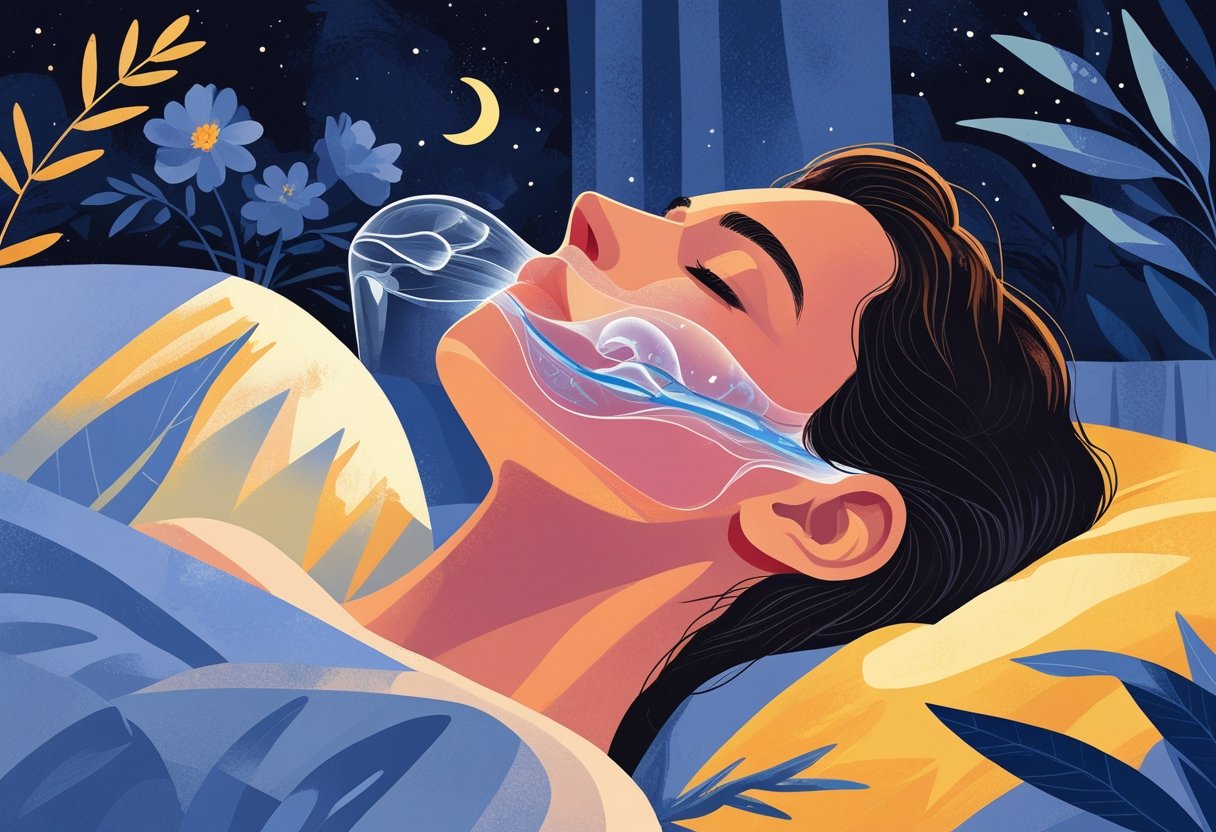
How Mattress and Sleep Position Affect Post-Nasal Drip Relief
The way a person sleeps and the mattress they use can influence how well post-nasal drip symptoms are controlled. Sleeping flat on the back often causes mucus to pool in the throat, which may worsen irritation.
Elevating the head is important. A wedge pillow or an adjustable mattress that keeps the upper body slightly raised encourages mucus to drain rather than collect, which helps reduce congestion and coughing.
Sleeping on the side generally works better than lying flat on the back. This position allows mucus to flow more freely and may prevent irritation in the throat. Choosing between the right or left side depends on personal comfort and specific sinus conditions.
Mattress firmness also matters to some extent. A mattress that supports spinal alignment helps maintain proper posture throughout the night. This support can indirectly ease breathing and allow better mucus drainage.
Here is a summary of helpful sleep tips for post-nasal drip:
- Elevate the head with pillows or an adjustable bed
- Sleep on the side rather than flat on the back
- Use a firm mattress to support proper posture
- Keep the sleeping environment cool and clean
The Helix Midnight Luxe is a great mattress for those who want relief from post-nasal drip symptoms. Its medium-plush support combined with zoned lumbar reinforcement encourages proper spinal alignment, which helps maintain good sleeping posture and eases breathing throughout the night.
The mattress is great for side sleepers by providing multiple layers of memory foam that cradle the hips and shoulders, which promotes side sleeping, a position that prevents mucus from pooling in the throat and reduces irritation.
Besides, the mattress features a breathable TENCEL cover and an optional GlacioTex Cooling Cover to keep the sleep environment cool and comfortable, reducing congestion and inflammation. Its combination of memory foam and individually wrapped coils limits motion transfer, which prevents disturbances caused by coughing or restlessness.
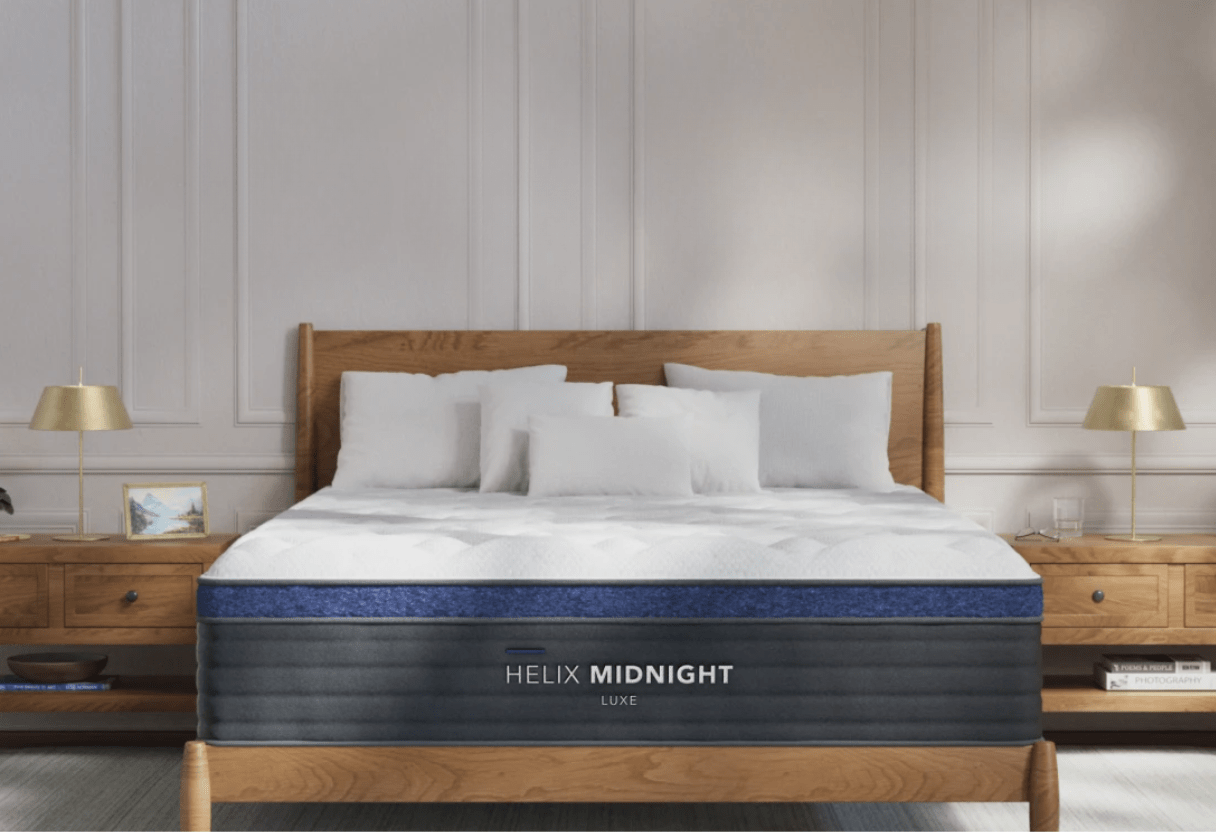
Frequently Asked Questions
Managing post nasal drip during sleep requires clearing mucus, adjusting sleeping position, and applying specific treatments. Controlling symptoms quickly improves breathing and reduces coughing.

